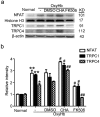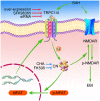Transient receptor potential channel 1/4 reduces subarachnoid hemorrhage-induced early brain injury in rats via calcineurin-mediated NMDAR and NFAT dephosphorylation
- PMID: 27641617
- PMCID: PMC5027540
- DOI: 10.1038/srep33577
Transient receptor potential channel 1/4 reduces subarachnoid hemorrhage-induced early brain injury in rats via calcineurin-mediated NMDAR and NFAT dephosphorylation
Abstract
Transient receptor potential channel 1/4 (TRPC1/4) are considered to be related to subarachnoid hemorrhage (SAH)-induced cerebral vasospasm. In this study, a SAH rat model was employed to study the roles of TRPC1/4 in the early brain injury (EBI) after SAH. Primary cultured hippocampal neurons were exposed to oxyhemoglobin to mimic SAH in vitro. The protein levels of TRPC1/4 increased and peaked at 5 days after SAH in rats. Inhibition of TRPC1/4 by SKF96365 aggravated SAH-induced EBI, such as cortical cell death (by TUNEL staining) and degenerating (by FJB staining). In addition, TRPC1/4 overexpression could increase calcineurin activity, while increased calcineurin activity could promote the dephosphorylation of N-methyl-D-aspartate receptor (NMDAR). Calcineurin antagonist FK506 could weaken the neuroprotection and the dephosphorylation of NMDAR induced by TRPC1/4 overexpression. Contrarily, calcineurin agonist chlorogenic acid inhibited SAH-induced EBI, even when siRNA intervention of TRPC1/4 was performed. Moreover, calcineurin also could lead to the nuclear transfer of nuclear factor of activated T cells (NFAT), which is a transcription factor promoting the expressions of TRPC1/4. TRPC1/4 could inhibit SAH-induced EBI by supressing the phosphorylation of NMDAR via calcineurin. TRPC1/4-induced calcineurin activation also could promote the nuclear transfer of NFAT, suggesting a positive feedback regulation of TRPC1/4 expressions.
Figures








Similar articles
-
Potential contribution of SOCC to cerebral vasospasm after experimental subarachnoid hemorrhage in rats.Brain Res. 2013 Jun 23;1517:93-103. doi: 10.1016/j.brainres.2013.01.004. Epub 2013 Mar 27. Brain Res. 2013. PMID: 23542055
-
MEK/ERK- and calcineurin/NFAT-mediated mechanism of cerebral hyperemia and brain injury following NMDA receptor activation.Biochem Biophys Res Commun. 2017 Jun 24;488(2):329-334. doi: 10.1016/j.bbrc.2017.05.043. Epub 2017 May 8. Biochem Biophys Res Commun. 2017. PMID: 28495529
-
Counteracting effect of TRPC1-associated Ca2+ influx on TNF-α-induced COX-2-dependent prostaglandin E2 production in human colonic myofibroblasts.Am J Physiol Gastrointest Liver Physiol. 2011 Aug;301(2):G356-67. doi: 10.1152/ajpgi.00354.2010. Epub 2011 May 5. Am J Physiol Gastrointest Liver Physiol. 2011. PMID: 21546578
-
Novel mechanism of endothelin-1-induced vasospasm after subarachnoid hemorrhage.J Cereb Blood Flow Metab. 2007 Oct;27(10):1692-701. doi: 10.1038/sj.jcbfm.9600471. Epub 2007 Mar 28. J Cereb Blood Flow Metab. 2007. PMID: 17392694
-
[Functional roles of constitutively active calcineurin in delayed neuronal death after brain ischemia].Yakugaku Zasshi. 2011 Jan;131(1):13-20. doi: 10.1248/yakushi.131.13. Yakugaku Zasshi. 2011. PMID: 21212608 Review. Japanese.
Cited by
-
TRPC1 Channels Are Expressed in Pyramidal Neurons and in a Subset of Somatostatin Interneurons in the Rat Neocortex.Front Neuroanat. 2018 Feb 26;12:15. doi: 10.3389/fnana.2018.00015. eCollection 2018. Front Neuroanat. 2018. PMID: 29535613 Free PMC article.
-
Long non-coding RNA TUG1 knockdown prevents neurons from death to alleviate acute spinal cord injury via the microRNA-338/BIK axis.Bioengineered. 2021 Dec;12(1):5566-5582. doi: 10.1080/21655979.2021.1966258. Bioengineered. 2021. PMID: 34517787 Free PMC article.
-
A Novel Mechanism Linking Melatonin, Ferroptosis and Microglia Polarization via the Circodz3/HuR Axis in Subarachnoid Hemorrhage.Neurochem Res. 2024 Sep;49(9):2556-2572. doi: 10.1007/s11064-024-04193-x. Epub 2024 Jun 18. Neurochem Res. 2024. PMID: 38888828
-
Inhibition of LRRK2-Rab10 Pathway Improves Secondary Brain Injury After Surgical Brain Injury in Rats.Front Surg. 2022 Jan 5;8:749310. doi: 10.3389/fsurg.2021.749310. eCollection 2021. Front Surg. 2022. PMID: 35071308 Free PMC article.
-
The blood-brain barrier and the neurovascular unit in subarachnoid hemorrhage: molecular events and potential treatments.Fluids Barriers CNS. 2022 Apr 11;19(1):29. doi: 10.1186/s12987-022-00312-4. Fluids Barriers CNS. 2022. PMID: 35410231 Free PMC article. Review.
References
Publication types
MeSH terms
Substances
LinkOut - more resources
Full Text Sources
Other Literature Sources

